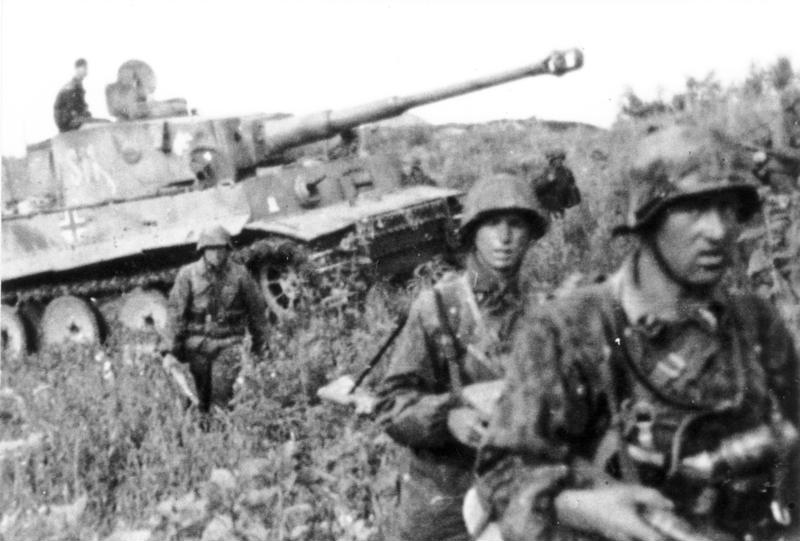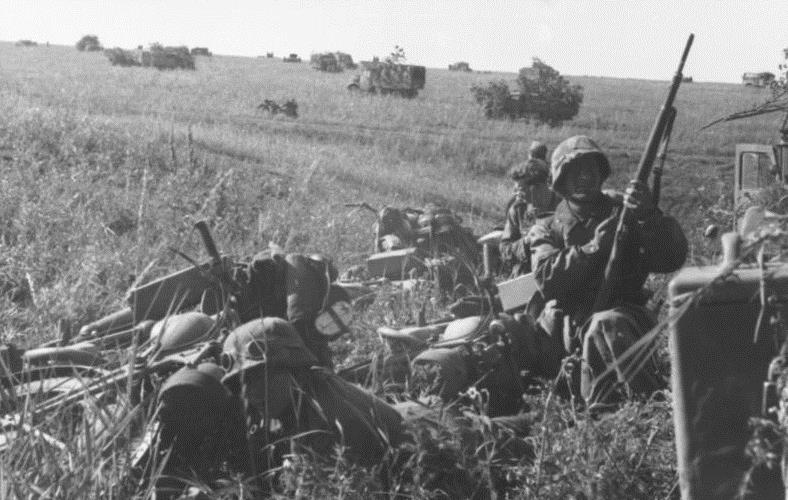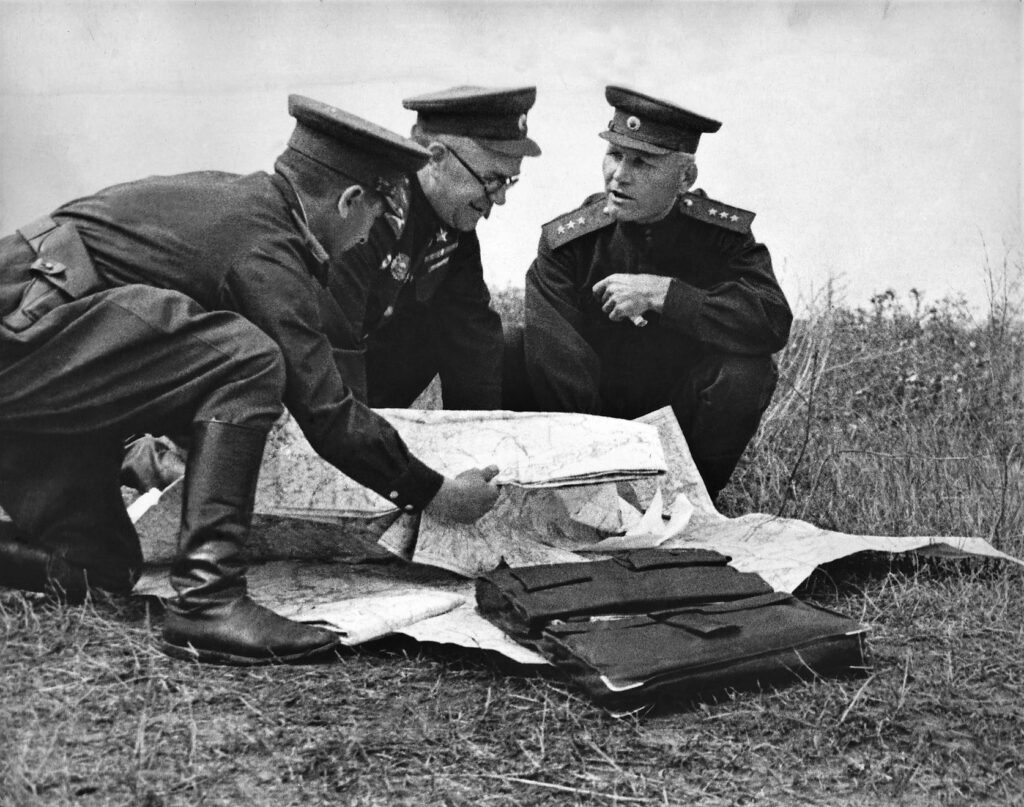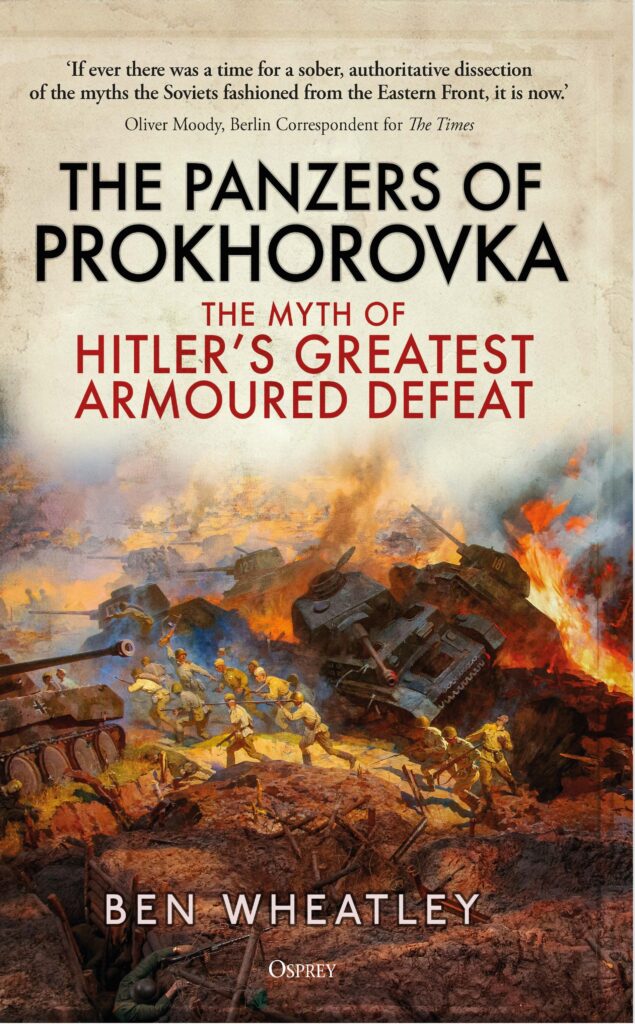Fought during 5 July – 23 August 1943, the Battle of Kursk was the largest tank battle in history. Beginning with a German offensive called Operation Citadel, the battle would ultimately involve thousands of tanks and aircraft as well as millions of soldiers. Kursk became a famous Soviet victory that gave them the military initiative. From that point on, the Germans were only able to react in a limited way to Soviet advances and were never again able to launch a major offensive on the Eastern Front.
To understand why Kursk was such a large battle, it is important to understand the planning that took place beforehand. Here Dr Ben Wheatley, author of The Panzers of Prokhorovka: The Myth of Hitler’s Greatest Armoured Defeat, from the University of East Anglia, discusses the intense preparations in the build up to the battle. He reveals the strength and weaknesses of German and Soviet armoured forces, Hitler’s personal involvement and the myth about British intelligence’s role in the Soviet victory.
Scroll down for details on how you can win a copy of The Panzers of Prokhorovka: The Myth of Hitler’s Greatest Armoured Defeat
HoW: What conditions were the German and Soviet armoured forces in on the Eastern Front by mid-1943?
BW: The nadir of German armoured forces on the Eastern Front was reached in April 1943 (following the monumental battles of the previous winter – Stalingrad, etc) when the Germans could only call on a paltry 612 operational tanks on the entire Eastern Front. This was from a sparse pool of 1,336 tanks. By contrast, the Germans estimated they were still facing an enemy with over 6,000 tanks and assault guns at its disposal. Consequently, the Germans embarked on a major armoured rebuilding programme between April to July. However, it is often overlooked that so did the Soviets.
By early July 1943 the Soviet armoured force had once again reached staggering proportions. On the Eastern Front, the Soviets could call on 9,888 tanks and assault guns, with a further 311 facing the Finns. On the Southern-Far East Front, another 3,200 tanks and assault guns were deployed, while the Stavka (Soviet High Command) held 2,688 tanks and assault guns in reserve. This represented a monumental total of 16,087 tanks and assault guns. Facing this armoured colossus, the Germans had managed to pool 3,549 tanks and assault guns, to which the Finns could only add a further 100 tanks and assault guns.
HoW: Why was Kursk and its surrounding area considered an important military objective?
BW: Although the city of Kursk was an important centre for Soviet industry, this was largely considered irrelevant in German planning. Operation Citadel, as the German offensive against the Kursk salient would ultimately be known, had two key objectives. First, the operation was to straighten the front. By cutting off the protruding 120km-deep [75 mile] and 200km-wide [124 mile] Kursk salient (via a pincer attack at its base) a more favourable defensive line would be achieved, enabling troops to be withdrawn from the Eastern Front for the anticipated two-front war with the Western powers.
The second (and more realistic) objective was to weaken the massive Soviet forces concentrated in the Kursk area before they could launch an avalanche-like summer offensive. On 18 February 1943, Hitler had stated that he was “unable to undertake any large-scale operations this year” but “only small forays”. Operation Citadel was therefore conceived by General Kurt Zeitzler, chief of the Army General Staff, within this overall defensive context. Unlike in 1941 and 1942, no German plans existed for a strategic offensive to follow. Operation Citadel constituted a preventive attack with limited aims within an overall defensive strategy.
HoW: How did German and Soviet armoured forces prepare for the battle?
BW: Throughout the period of rebuilding between April and July 1943, both sides recognised the importance of the coming battles in the Kursk-Orel salients. Therefore, the majority of reinforcements were funnelled into this area. The Germans’ northern pincer of Operation Citadel was led by Army Group Centre’s 9th Army with 1,072 operational tanks, assault guns and tank destroyers. It was opposed by the Soviet Central Front’s 1,607 operational tanks and assault guns.
In the 9th Army’s rear Bryansk Front with 1,525 operational tanks and assault guns, and Western Front with 1,737 operational tanks and assault guns, stood ominously poised to strike against 2nd Panzer Army in the Orel salient. The 2nd Panzer Army possessed just 234 operational tanks and assault guns.
The Germans southern pincer was led by Army Group South’s 4th Panzer Army and Army Detachment Kempf with a combined strength of 1,451 operational tanks, assault guns and tank destroyers. They were opposed by the Voronezh Front’s 1,699 operational tanks and assault guns. A further 1,632 tanks and assault guns belonged to the Steppe Front (the Stavka strategic reserve). The German 2nd Army, with 100 operational assault guns (which saw no significant fighting in July) held the western edge of the Kursk salient.

HoW: Which tanks and armoured vehicles were available to the German and Soviet forces and which models were the most effective?
BW: In the summer of 1943 the Red Army, despite massive superiority in tank numbers, was still reliant on the T-34 tank with its 76mm main gun. This had become inferior in firepower to the latest German Panzer IV with its 75mm long-barrelled weapon. Significantly, by July this up-gunned Panzer IV was now present in large numbers. The German assault gun (StuG) and Marder II and III tank destroyers also utilised this powerful weapon and it again appeared in large numbers, as did the by now outdated Panzer III with its 50mm long-barrelled main gun. The Panzer III, however, could still prove a threat to Red Army armour.
The Panzer VI Tiger tank with its 88mm main gun, although only available in small numbers, was imperious on the battlefield. The Germans expected new armour, such as the Ferdinand tank destroyer with its extra-long-barrelled 88mm main gun and the Panther tank, with its extra-long-barrelled 75mm main gun, to prove a success on their debut.
Alongside the T-34, the Soviets also operated lightly armoured and under-gunned T-70 tanks, while effective assault guns were beginning to enter service with the Red Army in decent numbers. The powerful new Soviet 152mm assault gun was, however, extremely rare. The Red Army also had a small number Lend-Lease Anglo-American tanks such as the Lee and Churchill.
HoW: To what extent was Adolf Hitler personally involved in planning for Kursk?
BW: Hitler, of course, had the final say on every major planning decision. On 13 March, he issued Operations Order No5 for a pincer attack on the Kursk salient. Interestingly, on 18 April, Hitler ordered the planning of a viable alternative to Zeitzler’s version of Operation Citadel. Hitler proposed a concentrated frontal attack on the Kursk salient from the 2nd Army’s sector (Rylsk area) with the intention of splitting the Soviet forces in the Kursk salient. This would avoid the enemy’s most strongly fortified sectors of the salient and break through at the weak point.
Zeitzler, who flew to the Berghof two days later to talk Hitler out of his “remarkable variant”, wildly exaggerated the logistical difficulties that would be involved in its preparation. Zeitzler succeeded in changing Hitler’s mind. Contradicting Zeitzler on 19 April, Army Group Centre’s transport chief stated that the 9th Army could reach this new deployment zone in eight to ten days. Hitler also had the final say in delaying Citadel’s launch. After consultations with Walter Model (9th Army’s commander) and Heinz Guderian (inspector of Panzer Troops) Operation Citadel would be postponed on numerous occasions in May and June. It was finally scheduled for 5 July.
HoW: Which Soviet generals were in command for planning of Kursk and how effective were they as military leaders?
BW: The central figures planning the Soviet strategy for the summer of 1943 – and in particular the Battle of Kursk – were Marshal Georgy Zhukov, the deputy commander in chief, Marshal Aleksandr Vasilevsky, the chief of the general staff, and of course Stalin. By 1943, all three had become extremely competent in their respective roles.
Following the Soviets’ chastening defeat at Kharkov in March 1943, Stavka were wary of a further German offensive against the Kursk salient (which was the obvious target for any subsequent German offensive). However, Stalin was still in a buoyant mood following the recent victory at Stalingrad. In early April he argued that as soon as the Red Army had been sufficiently resupplied it should launch a pre-emptive strike against the Germans at Kursk.
In contrast, on 8 April Zhukov proposed to Stalin a strategic defence to absorb the coming German offensive at Kursk followed by a series of strong counter-offensives against the fatally weakened German forces. In the coming days, Central Front and Voronezh Front both backed Zhukov’s proposal. Finally, on 12 April during a meeting in Moscow, Zhukov and Vasilevsky convinced Stalin of the need for an initial defensive phase to the summer strategic offensive.

HoW: What did the Soviet defensive belts in and around Kursk consist of?
BW: The Soviets constructed eight staggered defence lines which stretched to a total depth of 300km [186 miles], including Steppe Front. Voronezh and Central Front had together laid 503,663 anti-tank and 439,348 anti-personnel mines. In the most important sectors there was a density of 1,500 anti-tank and 1,700 anti-personnel mines per kilometre.
Voronezh Front alone had installed 83,912 gun emplacements and machine-gun positions, 5,322 command and observation posts, 17,505 shelters and earth bunkers and 593km [368 miles] of wire obstacles. Similarly, huge defences existed in Central Front’s sector. At the point of main effort the concentration of artillery was 124 guns per kilometre.
The Germans faced a maze of ditches, tank-traps, wire obstacles, anti-tank fronts, minefields, blocking positions, flamethrower barriers and strongpoints with built-in guns. The enemy had to pass through a firewall of artillery, behind which masses of Soviet tanks awaited them.
HoW: The Battle of Kursk is famous for its extensive use of tanks but how important were aircraft and infantry?
BW: Absolutely vital. For example, the Germans would pay dearly for their relative lack of infantry during the Citadel offensive. The Panzer divisions were often tasked with undertaking roles which should have been allocated to infantry divisions, such as flank protection. The Soviets’ trump card was their mammoth amount of artillery. For Operation Citadel, Model’s 9th Army possessed 223,000 troops, 3,630 barrelled weapons and 640 aircraft, while their direct opponents – Central Front – could call on 510,983 troops, 12,453 barrelled weapons and 1,034 aircraft.
Model was distracted by the presence of vast formations to his rear facing the Orel salient and Bryansk Front with 335,068 troops, 10,199 barrelled weapons, 995 aircraft and Western Front with 226,043 troops, 5,802 barrelled weapons and 1,322 aircraft. Against this vast force, 2nd Panzer Army could only offer 107,000 troops and 2,050 barrelled weapons.
Army Group South’s 4th Panzer Army and Army Detachment Kempf had a combined strength of 215,271 troops, 2,847 barrelled weapons and 732 aircraft. Their opponent – Voronezh Front – possessed 466,236 troops, 9,751 barrelled weapons and 881 aircraft. In addition, Steppe Front stood ready to deploy 449,133 troops, 9,211 barrelled weapons and 1,205 aircraft. As stated, the German 2nd Army with 80,000 troops and 940 barrelled weapons held the western edge of the Kursk salient.

HoW: What role did British intelligence play in assisting the Soviets before the battle? If so, how important was its contribution?
BW: The importance of officially passed Ultra intelligence (the name given to decoded signal intelligence) is often over-hyped in the West. The Soviets were fully aware of the Germans’ offensive intentions against the Kursk salient via their own sources of intelligence. This included air reconnaissance, signals interception and foreign agents long before they received official notification from British Ultra intelligence of the obvious German build up.
At the end of April, Ultra picked up a comprehensive assessment by Army Group South of future German intentions at Kursk – which was passed to the Soviets on 30 April along with a warning that the attack would take place in the near future. For next two months, however, Ultra intelligence assessments were doubtful regarding future combat at Kursk (no doubt reflecting the Germans’ own misgivings). Ultra often gave contradictory information which limited its operational use. Ultra did not indicate the German offensive had begun until 10 July, which was the sixth day of the offensive. In other words, Ultra offered no advance warning.
HoW: Is there a counter-narrative possibility that Germany could have won the battle?
BW: The simple answer is no. There are several reasons for this. Firstly, there are questions as to how committed Model was to the offensive. His decision not to place his armour in the vanguard perhaps points to this. There is a definite sense that Model was protecting his armour for more important battles to come (such as the defence of the Orel salient). Model was also dissatisfied with the number of troop reinforcements 9th Army received, while he was very concerned that aerial reconnaissance had revealed the vast depth of Soviet defences. Further, by launching the offensive in July, the Germans had long since lost any element of surprise.
Conversely, had the offensive commenced as originally planned in April then it would have been launched during the notorious Rasputitsa (muddy season). It would have also been impossible to rehabilitate the German divisions by this date; 4th Panzer Army declared that the army would “not be operational before the beginning to middle of May”.
Fundamentally though, the Germans simply faced a vastly more powerful enemy. For Citadel, the Germans could call on 518,271 combat troops, 2,623 tanks, assault guns and tank destroyers, 7,417 barrelled weapons and 1,372 aircraft. However, they would face 1,426,352 Soviet combat troops, 4,938 tanks and assault guns, 31,415 barrelled weapons and 3,648 aircraft.
For your chance to win a copy of The Panzers of Prokhorovka by Dr Ben Wheatley, simply answer the question below:

